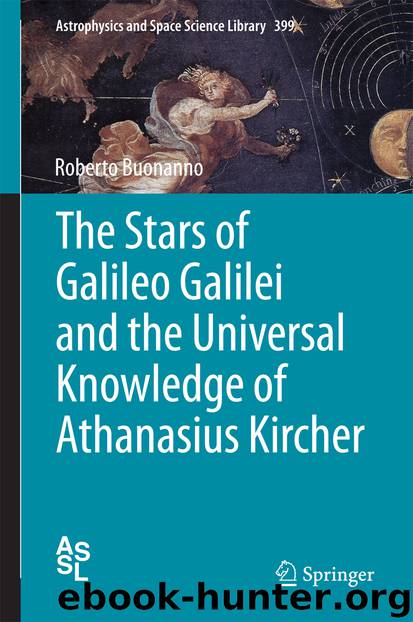The Stars of Galileo Galilei and the Universal Knowledge of Athanasius Kircher by Roberto Buonanno

Author:Roberto Buonanno
Language: eng
Format: epub
Publisher: Springer International Publishing, Cham
Galileo shows a peculiar hostility towards Scheiner, a hostility which almost appears distilled, in the sarcastic letter addressed to his friend Cesare Marsili whom, even before the publication of Rosa Ursina, Galileo openly dispenses from reading:“I have heard that the false Apelles is printing in Bracciano a long essay de maculis solis; since it is long, it makes me suspect that it may be full of nonsense, which, being infinite, may extend along many sheets, where the truth finds no space: I believe that, if he says something different from what I wrote in my solar Letters, he will only say vanities and lies”.35
Clearly, such a violent and persistent yearlong fight has deeper roots than the somewhat childish dispute about who observed sunspots first, also because both Scheiner and Galileo probably realize that neither the one nor the other can technically aspire to this record. Perhaps, Galileo considers Scheiner an authoritative representative of conservative Catholic ideology, whereas the Jesuit scholar surely feels a personal resentment towards Galileo. In any case, Galileo never misses the chance to criticize Scheiner’s works, not only in various offensive letters, which sooner or later reach the Jesuit, but also in the Dialogo sopra i due massimi sistemi (Dialogue concerning the two chief World Systems). He keeps the argument alive by criticizing both Rosa Ursina and Scheiner’s Disquisitiones. The Jesuit scholar, in his turn, will never forgive Galileo for his charge of plagiarism and will nurse such a persistent hatred that even Scheiner, after Grassi, has often been suspected of playing an active role in the charges against Galileo which are sent to the Holy Office. However, as we know, these suspicions have never been confirmed by documents, so that they are generally considered as unfounded.
Apart from inferences, it is interesting to analyse the debate on sunspots. As the two contenders measure each other, we may notice that the cosmological theory of the Jesuit scholar evolves in an anti-Aristotle direction, while Galileo, who grows more and more impatient, and cannot bear the caution of official culture, which only delays the official acceptance of Copernicus’ theory. Scheiner’s position is clearly expressed in his letters of 1611, in which he is forced to interpret sunspots as small satellites, similar to the recently discovered Jupiter’s satellites, which lie between the Sun and the Earth. Indeed, Scheiner must save the hypothesis according to which the Sun, just like all celestial bodies, is perfect, since it is made of an unchangeable matter, which is completely different from the one we find on Earth.
This position is modified in the period between the first letters and the publication of Rosa Ursina: although still faithful to the theory of a still Earth at the centre of the Universe, Scheiner finally gets rid of the idea that the Sun is a perfect body. As a consequence, the Jesuit scholar, in the book Rosa Ursina, has no difficulty in accepting that sunspots and faculae are on the surface of the Sun, “ipsae extra solem non sunt
Download
This site does not store any files on its server. We only index and link to content provided by other sites. Please contact the content providers to delete copyright contents if any and email us, we'll remove relevant links or contents immediately.
Tools of Titans by Timothy Ferriss(7813)
Turbulence by E. J. Noyes(7701)
Astrophysics for People in a Hurry by Neil DeGrasse Tyson(5001)
Secrets of Antigravity Propulsion: Tesla, UFOs, and Classified Aerospace Technology by Ph.D. Paul A. Laviolette(4992)
Design of Trajectory Optimization Approach for Space Maneuver Vehicle Skip Entry Problems by Runqi Chai & Al Savvaris & Antonios Tsourdos & Senchun Chai(4841)
Room 212 by Kate Stewart(4737)
Pale Blue Dot by Carl Sagan(4616)
The David Icke Guide to the Global Conspiracy (and how to end it) by David Icke(4380)
A Journey Through Divination and Astronomy by Publishing Pottermore(4250)
Apollo 8 by Jeffrey Kluger(3512)
Goodbye Paradise(3446)
Losing the Nobel Prize by Brian Keating(3425)
COSMOS by Carl Sagan(3348)
The Five People You Meet in Heaven by Mitch Albom(3335)
How to Read Water: Clues and Patterns from Puddles to the Sea (Natural Navigation) by Tristan Gooley(3240)
Brief Answers to the Big Questions by Stephen Hawking(3239)
How to Read Nature by Tristan Gooley(3078)
The Order of Time by Carlo Rovelli(3073)
A Brief History of Time by Stephen Hawking(2819)
